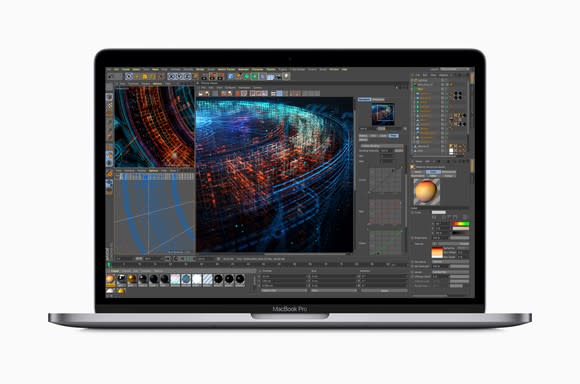Apple's MacBook Pro Gets the AMD Vega Treatment
On July 12, Apple (NASDAQ: AAPL) announced updated versions of its high-end MacBook Pro computers with significantly improved internals. The systems incorporate faster processors -- Apple claimed a 70% boost on the 15-inch model and a doubling in performance for the 13-inch variant -- as well as support for greater memory (32 GB of DRAM from a 16 GB maximum in the prior model). The systems also incorporate Apple's T2 companion chip as well as True Tone display technology.
In the 13-inch models, Apple uses the Iris Plus graphics that are integrated inside of the Intel processors, but for the 15-inch systems, Apple uses discrete graphics processors from Advanced Micro Devices (NASDAQ: AMD). The versions that Apple announced back in July -- and the ones that are available for sale -- can currently be configured with AMD's Radeon Pro 555X graphics or a higher-end version known as Radeon Pro 560X. These are both based on the company's older, lower-end Polaris architecture.

The 15-inch MacBook Pro. Image source: Apple.
Apple recently announced that, beginning in late November, it would allow buyers to configure the 15-inch MacBook Pro with AMD's newly announced Radeon Pro Vega 16 or its higher-end counterpart, Radeon Pro Vega 20 -- higher-end graphics processors compared with the Polaris-based Radeon Pro 555X and 560X parts.
Let's go over what this means for both Apple and AMD.
A win for both
To the extent that it can sell more expensive systems, Apple's Mac-related revenue and, presumably, profit stand to benefit.
When I go to Apple's website, the company lets customers choose from two 15-inch MacBook Pro systems to customize. The first comes with a 2.2 GHz six-core CPU, Radeon Pro 555X, and 256 GB of storage starting at $2,399. The second has a faster six-core CPU running at a base speed of 2.6 GHz, Radeon Pro 560X graphics, and 512 GB of storage for $2,799.
The $2,399 model can only be configured with up to the Radeon Pro 560X, which means that anybody who wants to get their hands on a Radeon Pro Vega-based MacBook Pro will also have to buy a system that fundamentally starts at a higher price. That's a clear win for Apple.
As far as AMD is concerned, keep in mind that every time Apple sells a 15-inch MacBook Pro, AMD already gets a graphics chip sale. The difference now is that if a customer picks a MacBook Pro with a Radeon Pro Vega, not only should Apple benefit by selling a pricier system, but AMD should benefit, too, by selling a pricier graphics processor.
Putting it all into context
Apple offering higher-end configurations of its MacBook Pro with AMD's Radeon Pro Vega graphics chips is a nice way for Apple and AMD to sell pricier systems and graphics chips, respectively, but this isn't a game changer for either company.
Remember that during its fiscal year 2018, Apple shipped around 18.2 million total Macs. That figure incorporates shipments of a wide range of Mac laptop and desktop products. Shipments of the 15-inch MacBook Pro make up just a fraction of that total and shipments of the highest-end models with maxed-out graphics likely represent a fraction of those shipments.
Ultimately, this announcement isn't something that should have a meaningful impact on the investment theses around either Apple or AMD.
More From The Motley Fool
Ashraf Eassa owns shares of Advanced Micro Devices. The Motley Fool owns shares of and recommends Apple. The Motley Fool has the following options: long January 2020 $150 calls on Apple and short January 2020 $155 calls on Apple. The Motley Fool has a disclosure policy.
